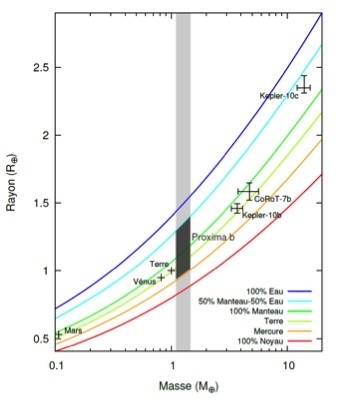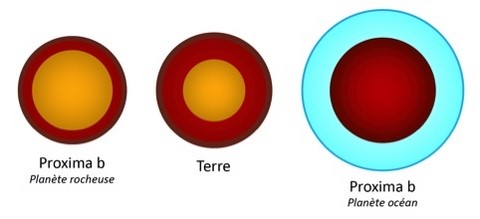Proxima b - our nearest exoplanet has an Ocean
A rocky planet, with a mass close to Earth’s, has been recently discovered around Proxima Centauri, the closest star to our own Sun. This planet, which has been named Proxima b, is situated on an orbit which would allow it to have liquid water at its surface,thus raising the question of its habitability. In a study to be published in The Astrophysical Journal Letters, an international team lead by researchers of the Marseille Laboratory of Astrophysics (CNRS/Aix-Marseille Université) has just ascertained its dimensions and the properties of its surface which would indeed favor habitability. According to them, this could be an « ocean-type planet, » with an ocean covering its whole surface, and water akin to the water of some of the icy moons around Jupiter or Saturn. The scientists also show that the composition of Proxima b might resemble the one of Mercury, with a metal core making out two thirds of the planet’s mass. These results will serve as a basis for future studies aiming at establishing the habitability of Proxima b.
Proxima Centauri, the closest star to our Sun, harbors a planetary system composed of at least one planet. This discovery was recently made by the way of analyzing and completing older observations, thus staking out a domain of research in exo-planets. The new measures have shown that this planet, called Proxima Centauri b – or more simply Proxima b –, has a mass close to the one of Earth (1.3 times the latter) and is orbiting around its star at a distance of 0,05 astronomical units (that’s one tenth of the distance of the Sun to Mercury). Contrarily to what one may think, such a distance does not imply an elevated temperature at the surface of Proxima b. Proxima Centauri being a red dwarf, its mass and its radius are only one tenth of the Sun’s, and its luminosity is one thousand times less. At such a distance, Proxima b finds itself situated within the habitable zone of its star. It is susceptible to have liquid water at its surface and therefore some forms of life.

Figure 1 – Mass-radius diagram comparing the positions of several exoplanets known to those of the solar system. The curves correspond to some specific compositions used in the internal structure model. The existence zone of Proxima b is shaded in grey and takes into account the uncertainties about its mass and its various possible compositions.
Yet we know very little about Proxima b, its radius in particular remains unknown. It is therefore impossible to know what the planet looks like, nor of what it is composed. The measure of the radius of an exoplanet is normally taken at the occasion of a transit, when the latter eclipses its star. But this is an event of a weak probability (1,5%), and several observations of the star have not shown any sign of a transit.
There is another way of estimating the radius of a planet if one knows its mass, namely by simulating the behavior of the material composing it. This is the method used by a French-American team of researchers from the Laboratoire d’Astrophysique de Marseille (CNRS/Aix-Marseille Université) and the Department of Astronomy of Cornell University. With the help of an internal structure model, they have explored the various compositions that might be displayed by Proxima b and have deduced from them the corresponding values of the radius of the planet. They limited their study to the case of potentially inhabitable planets, simulating dense and solid planets, formed of a metallic core and a rocky mantle, such as the telluric planets in the solar system, while allowing for the incorporation of an important mass of water in their composition.

These hypotheses allow for a great diversity of compositions for Proxima b, as the radius of the planet can vary between 0,94 and 1,40 times the Earth’s radius (6,371 km). The study goes to show that Proxima b has a minimum radius of 5,990 km, and that the only way to obtain such a value is to have a very dense planet, composed of a metallic core of a mass amounting to 65% of the mass of the planet, the rest being made up of a rocky mantle (formed of silicates) present all the way to the surface. The border between these two materials would then be situated at a depth of ca 1,500 km. With such a composition, Proxima b would be very close in nature to the planet Mercury, which also presents a very massive metallic core. This first case however does not exclude the presence of water at the surface of the planet, as on Earth, where the mass of water does not exceed 0,05% of the planet’s mass. Contrarily, Proxima b might also present a maximal radius of 8,920 km, provided that it be composed of 50% of rock, surrounded by 50% of water. In this case, Proxima b would be covered with one single liquid ocean, 200km deep. Below, the pressure of the water would be so great that the water would transform itself into high pressure ice, before reaching the border with the mantle at a depth of 3100 km. In both of these extreme cases, a thin gaseous atmosphere could enrobe the planet, as on Earth, rendering Proxima b potentially inhabitable.
Such results also bring complementary informations for the various scenarii which have been proposed for the formation of Proxima b. Some imply a totally dry planet, while others allow for the presence of a significant quantity of water in its composition. The work of the research team makes it possible to make an estimate of the radius of the planet in each of these scenarii. Similarly, it allows to put a limit to the quantity of water available on Proxima b, which is subjected to evaporation under the influence of the ultra-violet rays and the X-rays of the host star, which are far more violent than those originating from the Sun.
Future observations of Proxima Centauri will make it to possible to refine this study. Particularly, measuring of stellar abundance in heavy elements (Mg, Fe, Si…) will diminish the number of possible compositions for Proxima b, while allowing a yet more precise determination of its radius.
Bastien Brugger,
Olivier Mousis,
Magali Deleuil
Marseille, October 6, 2016
Translated from the French by Anne-Marie de Grazia

